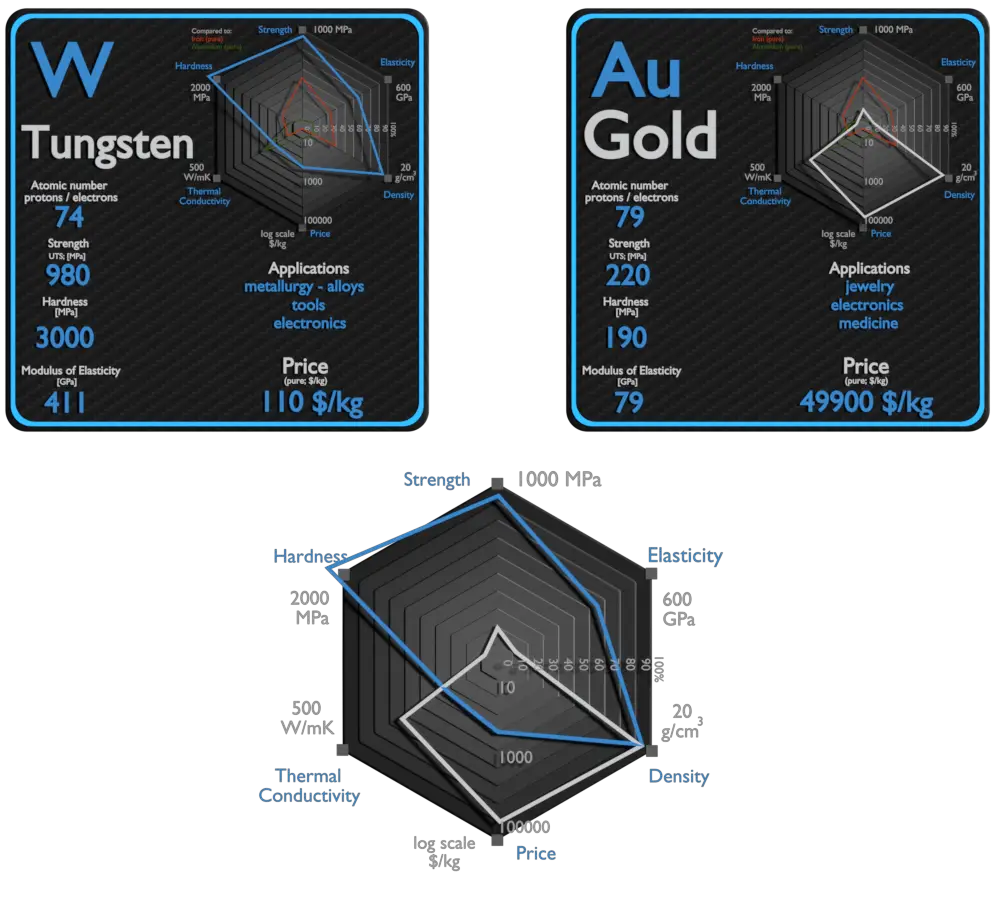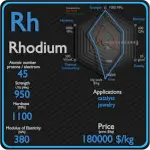This article contains comparison of key thermal and atomic properties of tungsten and gold, two comparable chemical elements from the periodic table. It also contains basic descriptions and applications of both elements. Tungsten vs Gold.

Tugsten and Gold – About Elements


Source: www.luciteria.com
Tungsten and Gold – Applications
Tungsten
Tungsten is widely used metal. Approximately half of the tungsten is consumed for the production of hard materials – namely tungsten carbide – with the remaining major use being in alloys and steels. Mining and mineral processing demand wear-resistant machines and components, because the energies and masses of interacting bodies are significant. For this purposes, materials with the highest wear-resistance must be used. For example, tungsten carbide is used extensively in mining in top hammer rock drill bits, downhole hammers, roller-cutters, long wall plough chisels, long wall shearer picks, raiseboring reamers, and tunnel boring machines. The remaining 40% is generally used to make various alloys and specialty steels, electrodes, filaments, wires, as well as diverse components for electric, electronic, heating, lighting, and welding applications. High-speed steels are complex iron-base alloys of carbon, chromium, vanadium, molybdenum, or tungsten (as much as 18%), or combinations there of.
Gold
Gold is used extensively in jewellery, either in its pure form or as an alloy. About 75% of all gold produced is used in the jewelry industry. Pure gold is too soft to stand up to the stresses applied to many jewelry items. Craftsmen learned that alloying gold with other metals such as copper, silver, and platinum would increase its durability. The term ‘carat’ indicates the amount of gold present in an alloy. 24-carat is pure gold, but it is very soft. 18- and 9-carat gold alloys are commonly used because they are more durable. Gold’s high malleability, ductility, resistance to corrosion and most other chemical reactions, and conductivity of electricity have led to its continued use in corrosion resistant electrical connectors in all types of computerized devices (its chief industrial use). Gold is also used in infrared shielding, colored-glass production, gold leafing, and tooth restoration. Only 10% of the world consumption of new gold produced goes to industry, but by far the most important industrial use for new gold is in fabrication of corrosion-free electrical connectors in computers and other electrical devices.
Tungsten and Gold – Comparison in Table
| Element | Tungsten | Gold |
| Density | 19.25 g/cm3 | 19.3 g/cm3 |
| Ultimate Tensile Strength | 980 MPa | 220 MPa |
| Yield Strength | 750 MPa | 205 MPa |
| Young’s Modulus of Elasticity | 411 GPa | 79 GPa |
| Mohs Scale | 7.5 | 2.75 |
| Brinell Hardness | 3000 MPa | 190 MPa |
| Vickers Hardness | 3500 MPa | 215 MPa |
| Melting Point | 3410 °C | 1064 °C |
| Boiling Point | 59300 °C | 2970 °C |
| Thermal Conductivity | 170 W/mK | 320 W/mK |
| Thermal Expansion Coefficient | 4.5 µm/mK | 14.2 µm/mK |
| Specific Heat | 0.13 J/g K | 0.128 J/g K |
| Heat of Fusion | 35.4 kJ/mol | 12.55 kJ/mol |
| Heat of Vaporization | 824 kJ/mol | 334.4 kJ/mol |
















